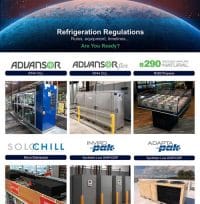
Environmental Protection Agency (EPA)
The EPA’s Significant New Alternatives Policy (SNAP) was instituted under Section 612 of the Clean Air Act to identify and evaluate alternatives for ozone-depleting substances. The SNAP program seeks to understand the overall effect of these substances on our health and environment while gathering knowledge and evaluating information on the alternatives available that could be acceptable substitutes that pose less of a risk to the population as a whole.
Significant New Alternatives Policy (SNAP)
The Refrigeration and Air Conditioning sector is just one of eight that fall under SNAP’s risk framework. In order to come to a decision on acceptable substitutes, an analysis of the risks is performed from the various substitutes in different industrial and consumer uses that have historically used ozone depleting substances. When evaluating each proposed alternative, they look at things like ozone depleting potential, global warming potential (GWP), toxicity, flammability, among other items. Through these evaluations, a list of acceptable and unacceptable substitutes is generated for each of the major sectors and are updated many times throughout the year. SNAP regulations have many rules, but the ones that pertain to the food retail refrigeration are the following:
- Rule 19 – Refrigerant Alternatives
- Rule 20 – Prohibition on the use of certain high-GWP HFCs as alternatives
- Rule 21 – New listings of safer substitutes and prohibition on the use of certain high-GWP alternatives (December 1, 2016)
- Rule 22 – Revised use conditions for hydrocarbon refrigerants as substitutes for household refrigerators and freezers
- Rule 23 – New listings for refrigeration and air conditioning and foams; revised listing for fire suppression
- Proposed Rule 25 – Listing of Substitutes under the Significant New Alternatives Policy Program in the Refrigeration & Air Conditioning
and Fire Suppression Sectors - Proposed Rule 26 – Listing of Substitutes under the Significant New Alternatives Policy Program in Commercial and Industrial Refrigeration
Additional Resources
CARB – The Refrigerant Management Program (RMP) requires facilities with refrigeration systems containing more than 50 pounds of high-GWP refrigerant to conduct and report periodic leak inspections, promptly repair leaks; and keep service records on site. The regulation also requires service practices intended to minimize refrigerant emissions. Read More>
- CARB Service Technicians
- CARB Distributors/Wholesalers and Reclaimers
- CARB Rules for Businesses with Refrigeration Systems
- SNAP Substitutes in Refrigeration and Air Conditioning
- SNAP Regulations including Rules 19-23
- Questions and Answers About SNAP Alternatives
- EPA Ozone-Depleting Substances – This page provides information on compounds recognized as ozone-depleting substances (ODS) under the Montreal Protocol.
- EPA Stationary Refrigeration Leak Repair Requirements including Section 608 of the Clean Air Act.
- DOE Compliance Certification Database Walk-In Coolers and Freezers – Doors
- DOE Energy Conservation Standards for Walk-in Cooler and Freezer Refrigeration Systems; Final Rule
